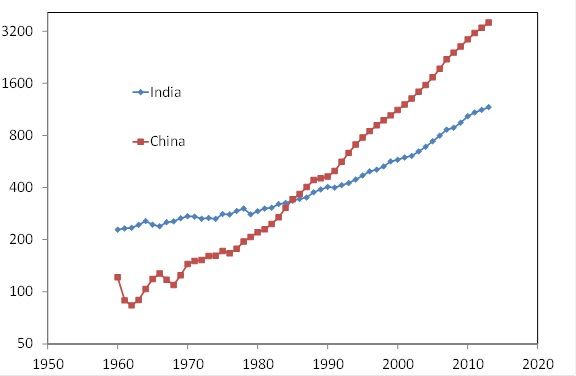According to the IMF, India will overtake China to be the fastest growing economy this year. In this article, Chetan Ghate and Peter Robertson assess the validity of this claim. In their view, the challenge for India is to not only catch up with China, but to also catch up with itself. Strong democratic institutions and the right economic reforms can work in India’s favour.
In a recent media interview, Chief Economic Adviser to the Government of India, Arvind Subramanian, said: “We are going to grow faster because we are poorer, so the fact that we are going to overtake China is good. But it is a reflection of how poorer we are than China in level terms. The flip puzzle for India is not that it is going to overtake China, but why it didn’t do so earlier”.
India’s economy snatched world headlines recently with upward revisions to GDP (gross domestic product) growth and the IMF’s (International Monetary Fund) suggestion that India’s growth rate is likely to exceed China by 2016. But how likely is this?
If India can grow like China it will join a relatively exclusive club of aptly named “growth miracle” economies, such as Japan and South Korea. But for every successful growth miracle, there are many countries for which growth has stalled midway through their transition, and many more that never even got started. Thus the main stylised fact of world growth across countries is divergence - the rich countries get richer and poor countries stay poor. So the claim that India will be the next miracle economy is a not a trivial one.
Elephant vs. dragon
Since its reforms in the 1990s, India’s economy has averaged 6.5% - 7% aggregate annual growth. Although this means that it escaped the Malthusian trap1, it has still lagged significantly behind China’s growth rate of 10% per year. Figure 1 below shows that India’s GDP per capita was overtaken by China in about 1990 and has slid further behind. Having been three times richer than China in the 1960s, India is now three times poorer.
Figure 1. GDP per capita in China and India (at constant prices, 2005; in US$)

Source: World Bank World Development Indicators
The gap matters very much for people’s lives. Poverty rates in India remain much higher than China. In 2011, life expectancy at birth in China was 73 years versus 65 years in India. Child mortality under five years of age (per 1,000 children) was 66 in India versus 19 in China. Electricity consumption (MWh per person) was 0.5 in India versus 2.5 in China. Across a range of social indicators as summarised by the Human Development Index (HDI), India was 135 and China was 91 out of 187 countries in 2014.
India’s political leaders must take their share of the blame for this. The two pillars of economic growth are investment and productivity. In both cases, government policies play a key role by providing adequate infrastructure.
India’s lack of public infrastructure, however, is glaring. Non-defense capital expenditure by the public sector is less than 1% of GDP. Social infrastructure allocations – towards public health and public education – are marginally higher. The agricultural sector is still in a Malthusian trap with total factor productivity2 (roughly 1.5% annually during the period 1985-2005), barely keeping pace with population growth.
A key factor in India’s high poverty rates is the lack of job creation in manufacturing. Whereas Chinese growth relied heavily on large quantities of physical capital in manufacturing, India’s best performance has come from human capital-intensive service sectors. But this service sector growth has mainly benefited the educated middle class and is not employment intensive.
A thriving manufacturing sector would have created more opportunities for the poor. But with few opportunities for factory employment, the incentives to attend school are low. This is reflected in India’s low primary and secondary education completion rates, a lack of attendance, and high teacher absenteeism.
This is critical because, unlike China, India is a young country - approximately half of its population is under 25 years old. Government is also critical here in order to deregulate constraints on manufacturing, such as labour laws and export taxes, and facilitate investment in teachers and school infrastructure.
India’s failures relative to its potential can also be seen starkly when we look at regions across the country. The richest district in India, Jamnagar, in the state of Gujarat, has a per capita income that is 36 times higher than the poorest district (Sheohar in Bihar). We show in recent work (Das, Ghate and Robertson 2015) that these gaps are getting larger rather than smaller. So the patterns within India mirror the world economy, with divergence rather than catch-up.
We also show that a significant fraction of divergence is due to remoteness – that is districts that are close to cities grow faster. Allowing for this, there is a pattern of catch-up, but at just 1.3% per year. At this rate a per-capita income gap between two districts would be reduced by only 10% over a decade.
Thus a lack of “trickle down”, despite free labour mobility, also appears to be an obstacle to higher national growth rates. Seen in this light, India’s challenge is not only a matter of catching up with China, but also of catching up with itself.
So what does India have going for it?
Adam Smith observed “Little else is requisite to carry a state to the highest degree of opulence from the lowest barbarism, but peace, easy taxes, and a tolerable administration of justice.” If one compares India with, for example its ‘twin country’ Pakistan, rather than China, it can be seen that India’s political stability, and a loyal pro-democratic military, have in fact served it well. Its strong democratic heritage is a secure basis for expecting peace and stability in the future.
India’s mature institutions are also India’s chief trump card over China. China has achieved success in growth, but the threat of political instability looms large on its horizon. It faces the problem of unbalanced growth between the interior and the coast, country and city, with extreme levels of inequality. The Chinese Communist Party (CCP) needs to redress these imbalances that will hurt its new middle classes, while maintaining authority and control.
As China’s growth slows, the CCP leadership will be increasingly more concerned with maintaining its own legitimacy – for example by fanning Sino-Japanese tensions and investing in larger internal para-military forces. It may become increasingly distracted from economic policies needed to navigate the ‘middle-income trap’.
So China faces many significant challenges. The historical precedent for this type of transition is the Soviet Union – which is a model that the CCP no doubt wishes to avoid. India’s problems, in principle, are much simpler. It has many examples to follow.
Against the backdrop of this robust institutional footing, the new leadership in India has given a boost to business expectations in the country. More than previous administrations, it understands that growth and markets are the foundations of development and prosperity. Under the NDA (National Democratic Alliance) government, there will be moves to improve the ease of doing business, attracting FDI (foreign direct investment) and boosting domestic investment, and strengthening governance. Also as a result of ongoing reforms, states are now increasingly competing on investments and economic performance rather than populism.
The miracle economies, including China, show that three decades of growth at 10% per year is attainable. But the costs of delay for India are enormous Every percentage point of growth below 10% represents wasted opportunities in terms of poverty reduction, jobs and schooling for future generations.
But if India’s politicians can accelerate economic reforms, encourage business and further develop its strong democratic institutions, it should have a very bright future. Mr Modi, over to you.
A version of this article has appeared on the IGC Blog.
Notes:
- In theory, Malthusian Trap refers to a situation in which the growth rate of population exceeds the growth rate of agriculture and hence, a stage would be reached when the food supply is inadequate for feeding the population.
- Total factor productivity refers to the efficiency with which inputs such as capital and labour are combined to produce outputs.
Further Reading
- Ghate, C and P Robertson (2014), ‘Understanding India’s unbalanced growth’, Ideas for India, 3 February 2014.
- Das, Samarjit, Chetan Ghate and Peter E Robertson (2015), “Remoteness, Urbanization, and India’s Unbalanced Growth”, World Development, Elsevier, Vol. 66(C), pp. 572-587.
- World Bank, ‘World Development Indicators’, Available online at: http://databank.worldbank.org/data/views/variableSelection/selectvariables.aspx?source=world-development-indicators#
- Sikawar D and V Pandey (2015), ‘Budget 2015 is visionary in starting a social security network: Arvind Subramanian’, Economic Times, 2 March 2015.




 23 March, 2015
23 March, 2015 





Comments will be held for moderation. Your contact information will not be made public.